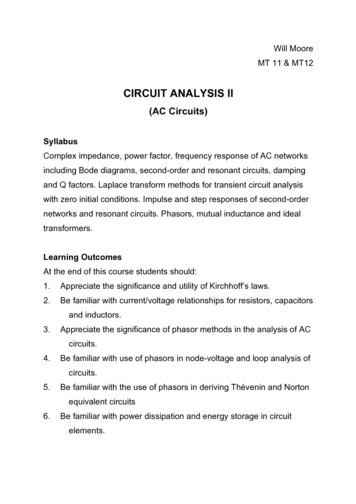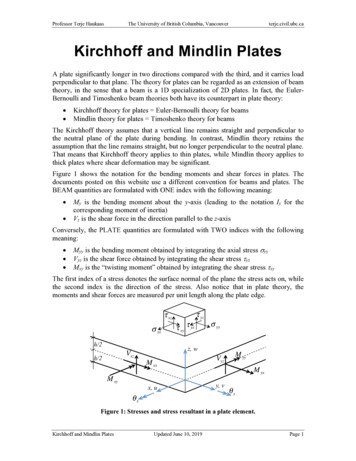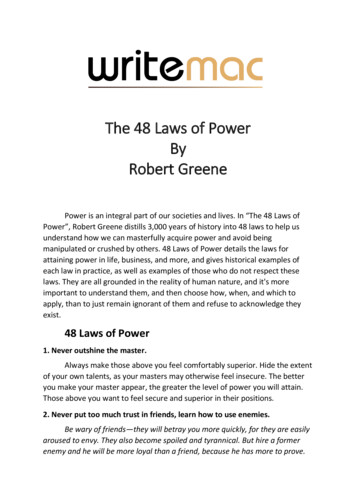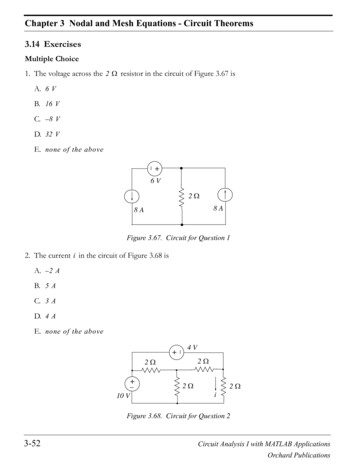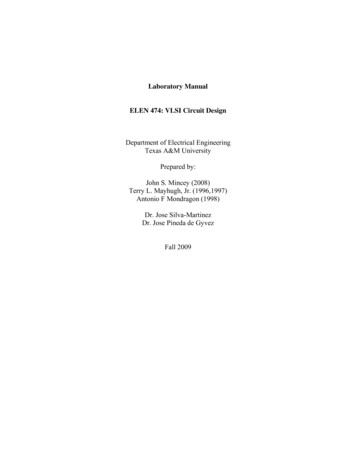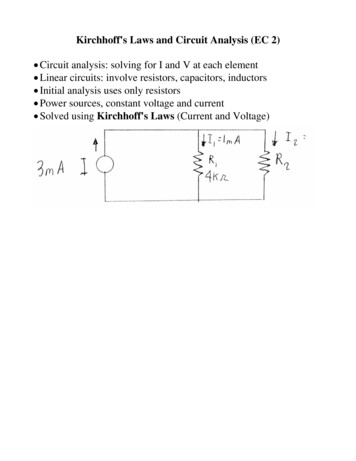
Transcription
Kirchhoff's Laws and Circuit Analysis (EC 2) Circuit analysis: solving for I and V at each element Linear circuits: involve resistors, capacitors, inductors Initial analysis uses only resistors Power sources, constant voltage and current Solved using Kirchhoff's Laws (Current and Voltage)
Circuit Nodes and Loops Node: a point where several wires electrically connect Symbolized by a dot or circle at the wire crossing If wires cross without a dot, then not connected Nodes also called junctions Typically give nodes a number or letter Branches: lines with devices connecting two nodes Loop: an independent closed path in a circuit There may be several possible closed paths
Kirchhoff's Current Law (KCL) Kirchhoff's Current Law (KCL) The algebraic sum of currents entering any node (junction) is zeroN Ij 0j 1where N number of lines entering the node NOTE: the sign convention: Currents are positive when they entering the node Currents negative when leaving Or the reverse of this.KCL is called a Continuity Equation:It says current is not created or destroyed at any node
Example of Kirchhoff's Current Law (KCL) Consider the simple parallel resistances below At node 1 define current positive into resistors Since V on R1 5V the current isI1 5V 5 mAR1 1000 Same V on R2 5V the current isI2 V5 1 mAR2 5000 Thus by KCL at node 1I1 I 2 I 3 0.005 0.001 I 3 0 Thus the total current isI 3 I1 I 2 6 mA Node 2 has the negatives of these values
Kirchhoff's Voltage Law (KVL) Kirchhoff's Voltage Law (KVL) Algebraic sum of the voltage drops around any loop or circuit 0N V j 0j 1where N number of voltage drops NOTE: the sign convention Voltage drops are positive in the direction of the set loop current Voltage drops negative when opposite loop current Voltage sources positive if current flows out of side Voltage sources negative if current flows into side A loop is an independent closed path in the circuit Define a "loop current" along that path Real currents may be made up of several loop currentsI R1 I1 I 2
Example Kirchhoff's Voltage Law (KVL)Consider a simple one loop circuitVoltages are numbered by the element nameeg. V1 or VR1 : voltage across R1Going around loop 1 in the loop directionRecall by the rules: Voltage drops negative when opposite loop current. Voltage sources positive if current flows out of sideV s V1 0
Example Kirchhoff's Voltage Law (KVL) Continued Thus voltage directions are easily defined here:V s V1 0 Why negative V1? Opposes current flow I1 SinceV1 I1 R1V s I1R1 0 Thus this reduces to the Ohms law expressionI1 VsR1
KVL Example Resistor Voltage Divider Consider a series of resistors and a voltage source Then using KVLV V1 V2 0 Since by Ohm’s lawV1 I1R1 V2 I1R2 ThenV I1R1 I1R2 V I1 ( R1 R2 ) 0 ThusI1 5V 1 mAR1 R2 2000 3000 i.e. get the resistors in series formulaRtotal R1 R2 5 KΩ
KVL Example Resistor Voltage Divider Continued What is the voltage across each resistor? Now we can relate V1 and V2 to the applied V With the substitutionI1 VR1 R 2 Thus V1V1 I1R1 5(2000)VR1 2VR1 R2 2000 3000 Similarly for the V2V1 I1R2 5(3000)VR2 3VR1 R2 2000 3000
KVL and KCL for Different Circuits With multiple voltage sources best to use KVL Can write KVL equation for each loop With multiple current sources best to use KCL Can write KCL equations at each node. In practice can solve whole circuit with either method
Resistors in Series (EC3) Resistors in series add to give the total resistanceNRtotal R jj 1 Example: total of 1, 2, and 3 Kohm resistors in series Thus total isRtotal R1 R2 R3 1000 2000 3000 6 KΩ Resistors in series law comes directly from KVL
Resistors in Parallel Resistors in parallel: Inverse of the total equals the sum of the inverses1RtotalN1j 1 R j This comes directly from KCL at the nodeI totalNNVV Ij Rtotal j 1j 1 R j NOTE: inverse of resistance called conductance (G) Units are mhos (ohms spelled backwards)NGtotal G jj 1 Thus when work in conductance change parallel to series equations
Example Parallel ResistorsExample 1K and 2K resistors in parallel1RtotalN1113000 1000 2000 2000000j 1 R j Rtotal 666 Ω
Example Parallel Resistors Example: two 1 Kohm resistors in parallel1RtotalN1112 K or K Rtotal 500 Ω1000 1000 1000j 1 R j Thus adding N same resistors cuts getRtotal Good way to get lower R valuesRN
Algebraic sum of the voltage drops around any loop or circuit 0 0 1 N j Vj where N number of voltage drops NOTE: the sign convention Voltage drops are positive in the direction of the set loop current Voltage drops negative when opposite loop current Voltage sources positive if current flows out of side


